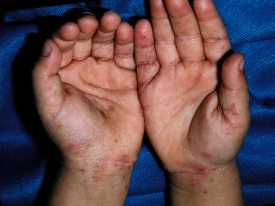Scabies

Facts about this itchy infection and symptoms to watch for.
Scabies is a skin infection caused by microscopic mites. The tiny mites burrow into the top layer of the skin, causing a rash and severe itching that can be worse at night.
The condition bears a stigma that people who contract it are “dirty.” But scabies can affect anyone of any age and is not related to hygiene.
Scabies is contagious and spreads through direct contact. The infection is commonly spread between family members, at school or daycare, between nursing home residents, or in shelters. Scabies is not transmitted from pets to humans.
What does a scabies infection look like?
Affected areas of the skin may show tiny red bumps or blisters that resemble burrow tracks. The rash can appear on any part of the body, but is most often found in adults:
- Between the fingers or toes
- In the armpits
- Around the waist
- At the wrists, ankles, or inner elbow
- Around the breasts
- In the genital region
Common sites in kids include the:
- Scalp
- Face
- Neck
- Palms of the hands
- Soles of the feet
Treatment options for scabies
Your doctor may recommend one or more of these treatment options to clear up the scabies infection and any secondary bacterial infections caused by excessive scratching:
- Antibiotics
- Antihistamines to reduce itch
- Ivermectin orally
- Lindane lotion
- Permethrin cream
- Sulfur ointments
Scabies mites can’t live more than three days once they’re away from human skin. However, it’s a good idea to thoroughly clean bedding, clothing, and towels you used while infected. Items that can go in the washer and dryer should be washed in hot water and dried on the hot cycle. Items that can’t be laundered should be separated from people for at least 72 hours to get rid of any remaining scabies mites.
.svg?iar=0&hash=F6049510E33E4E6D8196C26CCC0A64A4)

/hfh-logo-main--white.svg?iar=0&hash=ED491CBFADFB7670FAE94559C98D7798)